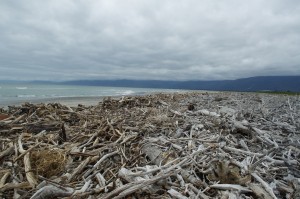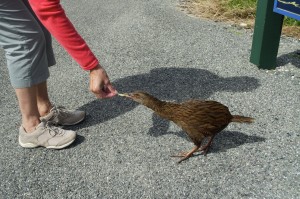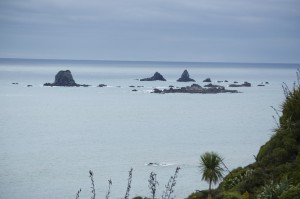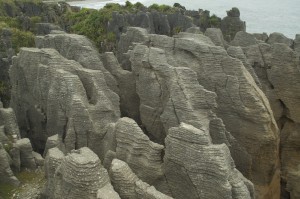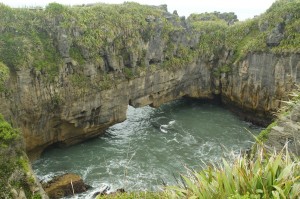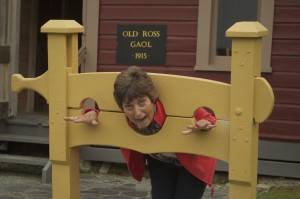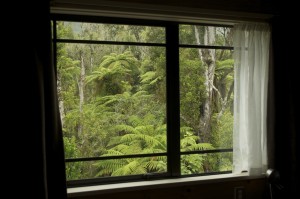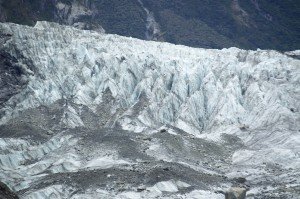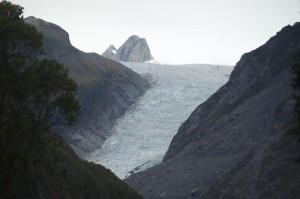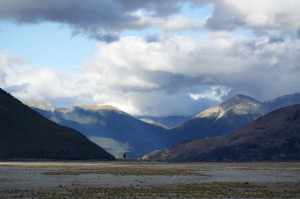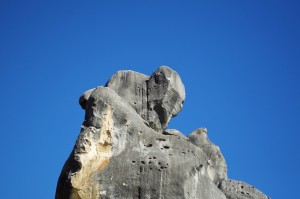With high pressure sitting firmly off the west coast of South Island and another off the east coast of North Island, the weatherman on TV was giving very positive information about the weather over the next few days. Two years ago we wanted to go to the Franz Josef and Fox Glaciers but the weather was so poor it was not worth the effort of getting there. Our plan initially was to just go to Hokitika to look at the gorge but If the weather remained good we might venture as far as the glaciers.
With such positive news we left Hanmer Springs while cloud still haloed the peaks but with the promise of another hot day. As we headed west any cloud was replaced with crystal clear skies. This was short lived as we descended from one range into valley mist before climbing once more into sunshine.
The town of Reefton might only be quite small but it was the first place in the Southern Hemisphere to install street lighting. Clearly the residents are proud of this claim to fame. We were passing through at midday and all the street lights were on. It is a shame that the installer never worked out how to turn them off.
As we crossed the next, coastal range of mountains more cloud greeted us and remained with us all the way to Westport. The weather man got it wrong, a layer of cloud obscured the sun they promised. The approach through the Buller Gorge was impressive.
Westport, population 6000, is not the most attractive town in South Island. It’s origins are from mining, first for gold and then much more successfully for coal. The only building with character is the Art Deco influenced civic building. Exploring the surrounding area we visited North Beach first. Rather worryingly a sign on the approach said that firearms and search lights were not allowed on the beach. Does that mean they are allowed in the town? Not a soul could be seen, perhaps for fear of being shot. However the grey sand was not particularly attractive but what covered the upper part of the beach made access difficult; wood debris from tree trunks to branches to twigs were piled up around the high water mark. Incredible to see but not to sit among.
On the southern side of town we went to Cape Foulwind, an exposed headland with a lighthouse to warn passing shipping. This provided us with our first encounter with a Weka, a flightless bird with absolutely no fear. At Cape Foulwind car park one came running up to us in search for food. I know we shouldn’t feed them but we were just eating a few crisps before we went up to the cape and before we realised what we were doing the Weka was taking crisps from our fingers. It is so enjoyable when nature comes so close to you and has no fear.
Off shore pinnacles of rock jut out of the water like teeth. Remarkably, only one tragedy has occurred.
Just round the corner from the cape is Tauranga Bay with an excellent restaurant on the southern side, where another Weka hovered by our feet in the hope of a chip or two, while on the northern side there is a seal colony . Between, surfers endeavoured to improve their skills.
Having settled into our accommodation we headed south for 60km to Punakaiki and the geological marvel of the pancake rocks and blow holes. The drive along the coast is superb with towering limestone, forested cliffs above us to our left and a rugged coastline to our right. Our aim was to get there for high tide and sunset in the hope that the combination of the two would produce some fabulous pictures. The rocks are superb. Having risen from the sea millions of years ago water, wind and the action of the sea has eroded them into fantastic shapes. The pancake appearance is because the rock is made up of layer upon layer like a series of contour lines.
A walkway leads you from one dramatic scene to another. All around and beneath us the sound of the sea working away at the rock could be seen and heard. Occasionally a great whoosh indicated trapped air in a blowhole but the tide was neither high enough or rough enough for the spray to come to the surface.
We were rather too early for high tide so we killed time by visiting a nearby Speights bar and restaurant for a drink. It was obvious that we were not going to get a sunset but I was still hoping for a blowhole display. The bar was run by three women who although friendly I would be reluctant to cross. They had a used look about them as if they were the offspring of gold prospectors or pioneers. Although friendly, I guess they would stand no nonsense.
Returning to the pancake rocks for high tide I was disappointed with the lack of action. The combination of a low high tide and a relatively placid sea meant that there would be no blowhole activity beyond a few teasing whooshes. Although disappointing, the pancake rocks are a fascinating spectacle and well worth a visit.
Back at the pub, this time for a meal, one if the women told me that to get the full display you need the highest tides combined with strong winds and a big swell. Everything had been against us, including the lack of a sunset.
On the return 60km drive to Westport I suggested Angela and I had a competition – guess the number of cars to pass us in the opposite direction – the loser making the tea when we got back to the motel. It was only 9.00pm so there was a good chance that there would be a few out and about. Angela suggested 10, me 8. Remarkably we were both significantly wrong, we saw 3! Angela made the tea. This exercise just highlights how quiet New Zealand roads are and what a pleasure it is to drive on them.
The next morning, with the promise of reasonable weather, we decided to change our loosely devised plan and drive to Franz Josef to have a look at the glacier. The forecast was not too bad but there was no guarantee that it was going to be as good as they said. It was worth the try. Our plans to visit Franz Josef and Fox Glaciers two years ago were thwarted by bad weather so we were hoping for better this time.
Retracing our steps of last night we continued beyond Punakaiki to the dismally named Greytown. It is not quite as dismal as it sounds but we had little inclination to linger there.
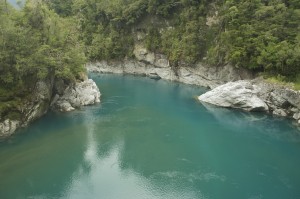 The next town was Hokitika. Here we deviated and took a 30km inland detour to have a look at the Hokitika Gorge. The drive took us across a flat plain of agricultural land dotted with small farms, none of which looked terribly prosperous. The flat plain gave way to cloud shrouded hills, which, if they were properly visible, would be mountains. Where the Hokitika River emerges from the mountains it has cut dramatically through the limestone. The combination of glacial silt and limestone has turned the water a beautiful blue.
The next town was Hokitika. Here we deviated and took a 30km inland detour to have a look at the Hokitika Gorge. The drive took us across a flat plain of agricultural land dotted with small farms, none of which looked terribly prosperous. The flat plain gave way to cloud shrouded hills, which, if they were properly visible, would be mountains. Where the Hokitika River emerges from the mountains it has cut dramatically through the limestone. The combination of glacial silt and limestone has turned the water a beautiful blue.
Returning to the main highway we continued our journey south, stopping again at the small gold rush town of Ross. Ross came into being in the 1860s with the discovery of gold and the population quickly grew to 2500. But it didn’t last and now the population is less than 300. Ross is proud of its heritage and the village is a living museum to the days if the gold rush. A series of trails take you to a number of mines or gold related sites while the town has a number of restored buildings. Those buildings which have not been restored, like the Roddy Nugget cafe, named after a 3.1kg gold nugget found in 1909, are an insight into Ross life. The back of the cafe had been turned into a museum displaying anything related to motorbikes, household goods and farming implements, a real treasure trove of rubbish. It appears not to be the only place like it.
On reaching Franz Josef we ventured up towards the glacier and climbed the small hill, the Sentinel, for a good view. At least that is what we should have had had the cloud not almost obliterated it from view. There was a hint of a glacier but nothing more. We returned to the village, a typical mountain resort, in the hope that the morning would bring clear skies.
Our accommodation for the night was the Rainforest Retreat, a series of cabins set amongst a forest of indigenous trees and ferns. The outlook from our cabin was stunning, a great picture of greenery and lushness. Despite being very busy, full of lively young people, mainly Americans, it was easy to lose them in the jungle. What was difficult to marry together was tropical rainforest with glaciers.
The morning dawned clear, so we quickly packed, and instead of returning to the Franz Josef Glacier, drove further south to the supposedly more spectacular Fox Glacier. It proved successful, the skies remained clear and good views were had. From the snout of the glacier a work team was cutting steps for the various groups who were to spend time on a guided tour on the glacier, making it easier for them to gain access to the ice. As we descended from our view point a couple of groups were heading in that direction.
All the time there was a constant droning noise from the air above as helicopter after helicopter flew over to take people up to the higher parts if the glacier and to view Mt. Cook, making the most if the good weather before the cloud returned and grounded the craft.
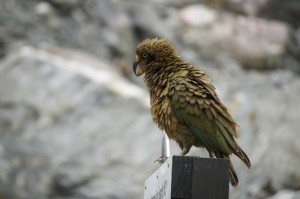 Also at the viewing point for the glacier was one of my favourite birds, the Kaka. It is a New Zealand parrot with a great sense of mischief and fun. They have little fear of people and will investigate anything left unattended. While there somebody put their wind proof jacket on the ground and while his back was turned the Kakas went through its pockets. It was as much fun watching them as it was looking at the glacier.
Also at the viewing point for the glacier was one of my favourite birds, the Kaka. It is a New Zealand parrot with a great sense of mischief and fun. They have little fear of people and will investigate anything left unattended. While there somebody put their wind proof jacket on the ground and while his back was turned the Kakas went through its pockets. It was as much fun watching them as it was looking at the glacier.
It was a wise decision to look at Fox Glacier as cloud began to build and by the time we returned to Franz Josef the glacier was largely obscured.
Once these glaciers flowed all the way down to the sea. Since then they have receded a great deal as the coast is now 19km away. While this recession has been happening over a long time, there has been an acceleration over the last century.
Our time in New Zealand is rapidly coming to an end, so having made our flying visit to the glaciers we now retraced our steps by heading north to turn inland just north of Hokitika for the climb to New Zealand’s highest road, Arthur’ Pass.
As we passed over the summit the grey cloud broke up, the light drizzle ceased and the sun broke through. It is often like this with the moist air from the sea forced up over the mountains. This is why the west coast of South Island often experiences much worse weather than the rest of the country. This side of the range is suddenly much less forested with large hillsides of open pasture and rock with just the occasional patch of forest. The river valleys are also much wider and flatter on this side of the range with gravel beds and braided rivers.
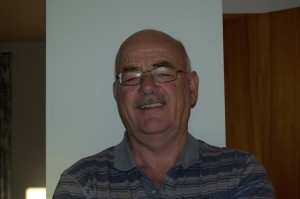 We were staying in the Bealey Hotel for one last night in the mountains before heading for Christchurch and our flight out. With a little time to kill I decided to tidy up my beard with a dry razor blade. I made such a pig’s ear of the job that I had to go the whole hog and shave it off completely. It took four razors to remove something that has been sprouting from my face for the last 24 years. Even when I played a pantomime dame I kept my beard. I kept the moustache, for now. Angela couldn’t stop laughing every time she looked at me. I hoped it made me look younger but now jowls are exposed and the youngish face that disappeared behind facial hair all those years ago is no longer! I look like my dad!
We were staying in the Bealey Hotel for one last night in the mountains before heading for Christchurch and our flight out. With a little time to kill I decided to tidy up my beard with a dry razor blade. I made such a pig’s ear of the job that I had to go the whole hog and shave it off completely. It took four razors to remove something that has been sprouting from my face for the last 24 years. Even when I played a pantomime dame I kept my beard. I kept the moustache, for now. Angela couldn’t stop laughing every time she looked at me. I hoped it made me look younger but now jowls are exposed and the youngish face that disappeared behind facial hair all those years ago is no longer! I look like my dad!
After breakfast on our last full day in New Zealand we drove to Christchurch. On the way we stopped off at Castle Hill, a ridge of sculpted limestone. Clambering amongst the rocks you were able to see a variety of shapes, which captured the imagination. One rock from one side looked like a glove puppet while on the other Angela thought it looked like an elephant while I thought it looked like an insect’s head. Nature’s art had created something much more impressive than a Henry Moore.
We arrived in Christchurch in glorious sunshine ahead of the forecast ‘once in a hundred years’ storm that is due to hit New Zealand just after we have left tomorrow. Didn’t they have one of those storms a couple of weeks ago? I think the blowholes at Punakaiki will be impressive on Sunday.

